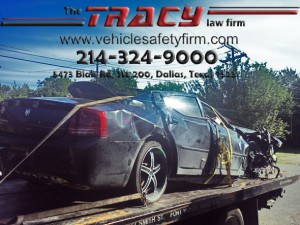For the vehicle to be crashworthy, various restraint systems must perform properly and prevent ejection and injurious contacts within the vehicle. One of the restraint systems known as seat must function properly during vehicle accidents to prevent ejection of the occupants from the vehicle.
Table of Contents
ToggleOccupant Ejection due to Seat Failure:
In a rear impact accident, the primary restraint system is the seat back. However, the seat rarely stays upright in rear impact accidents. As a result, even restrained people can be ejected. Seats routinely fail in accidents because the standard that governs seat strength was adopted in 1968 and has never been strengthened despite repeated attempts by the government. The problem with FMVSS 207 arises from the fact that the standard fails to take into account the weight of an occupant involved in an accident using the seat. Hence, in a parking lot accident, the seat can fail rearward. Further, here is no crash test requirement to evaluate seat strength. One test that does demonstrate how seats perform when a vehicle is impacted from the rear is a test that evaluates the fuel system (FMVSS 301). In most 301 tests, the front seated dummies are thrown into the rear seat when the seat back fails. Yet, as long as there is no fuel leakage, the failed seatback is of no consequence.
 In 1968, a GMC engineer acknowledged that a seat that was no longer upright could pose safety problems to pedestrians since the driver was no longer seated upright and could injure the driver and occupants sitting behind the driver. Yet, GMC and other vehicle manufacturers did nothing. Knowing that its seats would allow the driver to be deposited into the rear seat once the seat failed, manufacturers in the early 1970’s began testing seats that had seat belts attached to the seat. This design concept had been utilized for years by the military with life-saving results. Manufacturer testing revealed that using an ABTS system improved rear impact safety performance considerably. However, Land Rover was the only manufacturer to use the ABTS design in the 1970’s. By 1990, Mercedes Benz and BMW were the only other manufacturers that used the ABTS design. Today, only a handful of manufacturers use this superior restraint design.
In 1968, a GMC engineer acknowledged that a seat that was no longer upright could pose safety problems to pedestrians since the driver was no longer seated upright and could injure the driver and occupants sitting behind the driver. Yet, GMC and other vehicle manufacturers did nothing. Knowing that its seats would allow the driver to be deposited into the rear seat once the seat failed, manufacturers in the early 1970’s began testing seats that had seat belts attached to the seat. This design concept had been utilized for years by the military with life-saving results. Manufacturer testing revealed that using an ABTS system improved rear impact safety performance considerably. However, Land Rover was the only manufacturer to use the ABTS design in the 1970’s. By 1990, Mercedes Benz and BMW were the only other manufacturers that used the ABTS design. Today, only a handful of manufacturers use this superior restraint design.
Manufacturers routinely contend that when a seat back fails, the occupant benefits. They argue that with controlled seat deflection/yielding, the occupant actually benefits since they cannot ramp up the seat and impact the roof. They argue that any seat that remains upright is dangerous because the occupant does not get to ride down the crash event. However, they forget that most trucks that are not extended cab models and most sports cars have seats that cannot recline because the rigid structure is located behind the seat. Further, they forget that any vehicle that has a rear seat is incapable of having its rear seat yield rearward.
The defense to these cases started unraveling about nine years ago when a GMC seat litigation study surfaced. In the study, GMC lawyers and engineers expressed how seat back cases were not defensible. GMC’s chief biomechanical engineer has also testified and written in a book that he knew in the early 1980’s that GM’s seat performance was inadequate. Documents also surfaced that indicated that for less than $5.00, seats could be strengthened sufficiently to make them safe. Perhaps the most damning evidence came from the children that were being crushed by their parents or caregiver’s seats.
Therefore, the seat defects that results vehicle occupants to be ejected out of the vehicle causing serious personal injuries can file a vehicle crashworthiness case against the vehicle manufacturers. The founding attorney E. Todd Tracy of the TRACY firm in Dallas, Texas has tried many cases against vehicle and component parts manufacturers as GMC, Ford, Chrysler, Toyota, Nissan, Mazda, Honda, Mitsubishi, Ferrari, TRW, Key Safety, Allied Signal, Breed, Takata, JCI, and Dorel Juvenile Group that involved seat defects that causing injuries to the occupants of the vehicles.
Occupant Ejection through breaking Sunroof/Moon-roofs:
We have been also getting cases where sudden explosion of sunroof and moon-roof is taking place without any external force implied on the glass itself. But, if the vehicle is involved in an accident and the driver of the vehicle can be fully or partially ejected through the sunroof/moon roof and seriously injure themselves. Mostly the rollover type of accidents are common where the ejection occur through the sunroof/moon-roof. Please contact us immediately if you have been involved in vehicle glass breaking with or without injuries.
Contact:
Mr. Tracy strongly suggests that if you have been injured or had a loved one killed in vehicle accidents involving ejection of occupants, and you think it could be related to seat defect or any other defects like sunroof defect or moonroof defect, to contact his law firm and discuss it with one of the attorneys or staff members.
Source: E. Todd Tracy, The TRACY Firm, PJ | Nov. 30th 2014 | View (PDF)

